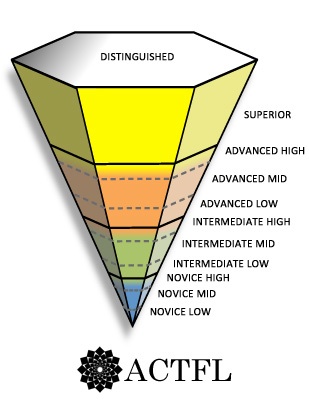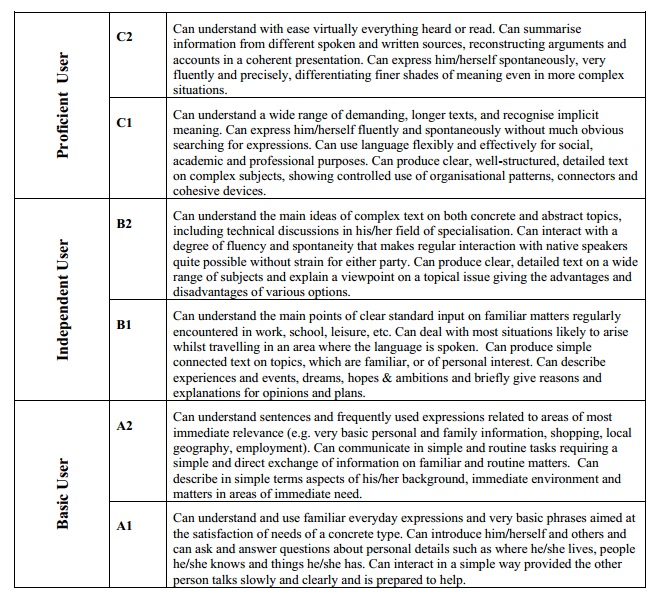How to Determine Your Language Proficiency Level: ILR, ACTFL, and CEFR Scales Posted by meaghan on Oct 22, 2014 in For Learners
You’ve heard the mantra: How can you know where you’re going if you don’t know where you’ve been? Cliché as it may be, this concept applies perfectly to learning a language. Knowing where you stand will help you set realistic goals, identify the resources that are best-suited for your level, and measure your progress over time.
So, here comes the obvious question: how do you determine your level in a given language? There are a few different well-known frameworks for assessing language learners by level:
Interagency Language Roundtable Scale (ILR)
Originally developed by the U.S. State Department’s Foreign Service Institute (FSI), and still known to many as the FSI scale, the ILR scale has been adopted as the standard measure of language proficiency for all U.S. Government agencies. The ILR describes learner proficiency on a rising scale ranging from 0-5, using plus (+) level designations between each base level to indicate that, while a learner has mastered the base level below and is able meet some of the requirements for the base level above, they are not yet able to sustain performance at that higher level.
- 0 – No Proficiency
- 1 – Elementary Proficiency
- 2 – Limited Working Proficiency
- 3 – General Professional Proficiency
- 4 – Advanced Professional Proficiency
- 5 – Functionally Native Proficiency
There is no actual “ILR exam”. The ILR does not actually administer tests. Rather, various government agencies use the ILR proficiency descriptors as a common measure of performance on their own specific language exams. The Foreign Service Institute, for example, administers their own custom language tests developed for Foreign Service officers, while the Defense Language Institute administers a different battery of tests developed for military personnel. I wouldn’t get your hopes up just to dash them like this though! While ILR-based tests are only available to U.S. government employees, the ILR does offer self-assessments, which you can find in the “Self Assessment” section at the bottom of this page. Want something more formal? Check out the next two options!
American Council on the Teaching of Foreign Languages Proficiency Scale (ACTFL)
Developed from the ILR scale, the ACTFL scale has 4 main levels (Novice, Intermediate, Advanced, and Superior), the first 3 of which are divided into 3 sub-levels (Low, Mid, and High). The guidelines for these levels are quite specific, especially at the lower levels. You can read about them on the ACTFL site here.
Unlike the ILR, ACTFL does administer proficiency tests—more than 200,000 every year! They offer oral proficiency tests in more than 100 languages, and also administer separate tests for measuring listening, reading, and writing proficiency. You can learn more about these tests on the ACTFL site here.
Common European Framework of Reference (CEFR)
Designed by the Council of Europe, the CEFR is widely accepted as the European standard for measuring language proficiency. The framework consists of 6 levels, with fully elaborated descriptors and can-do statements for reading, writing, listening, and speaking. A global scale is also provided to make it easier to communicate the system to non-specialist users and to provide teachers and curriculum planners working in different countries and languages with common orientation points:
Similar to the ILR, the Council of Europe does not offer a “CEFR exam”. Various testing centers and universities throughout Europe offer their own exams, aligned with the CEFR scale. If you’re looking to determine your CEFR level in a given language, you’ll want to sign up for one of these exams, such as:
- French:Diplôme d’études en Langue Française (DELF)
- Spanish:Diplomas de Español como Lengua Extranjera (DELE)
- German: Zertifikat Deutsch
- Russian: Test Po Russkomu Iazyku Kak Inostrannomu (TRKI)
- Italian: Note that Italy offers a range of exams, all of which have official status.
- Certificazione di Italiano como Lingua Straniera (CILS)
- Diploma Elementare di Lingua Italiana “Firenze” AIL. (DELI)
- Diploma Intermediodi Lingua Italiana “Firenze” AIL. (DILI)
- Diploma Avanzado di Lingua Italiana “Firenze” AIL. (DALI)
How do these proficiency scales relate?
Language proficiency is a continuum, and any attempt to divide that continuum up into distinct levels of proficiency will be imperfect. The ILR, CEFR and ACTFL proficiency scales each emphasize slightly different aspects of language proficiency and establish boundary markers at different points along that continuum. As such, they are not strictly comparable and one can’t really say that a particular level on one scale is the same as a given level on another scale. But many are interested in how the scales are related, so here’s an approximate comparison chart for receptive skill proficiency that many in the language community would consider imperfect, but not too far off.
| CEFR* | ACTFL | ILR |
| A1 | Novice High | 1 |
| A2 | Intermediate Mid/High | 1+ |
| B1 | Advanced Low/Mid | 2 |
| B2 | Advanced Mid/High | 2+ |
| C1 | Superior | 3 |
| C2 | Distinguished | 3+ |
To better understand how CEFR corresponds to ACTFL and ILR, we recommend this paper by Erwin Tschirner,
Looking for a quick, informal assessment of your language level? Take one of our free proficiency tests to get a approximation!

Build vocabulary, practice pronunciation, and more with Transparent Language Online. Available anytime, anywhere, on any device.






Comments:
Cathy Wilson:
Excellent post, Meaghan. Very helpful. I’m going to share on WeSpeke social media.
Cathy
James O’Donnell:
The comparison chart is lacking a credit. This comparison is based on which study and by whom? Is this comparison the one established by the American University Center of Provence?
There are many published variations in the proposed equivalencies between language proficiency scales. Please take a look at p. 40 of Baztán, Alfonso Martínez (2008). La evaluación oral: una equivalencia entre las guidelines de ACTFL y algunas escalas del MCER (doctoral thesis). Universidad de Granada. p. 461. ISBN 978-84-338-4961-8.
Matinez et Buritago both state that ACTFL’s IH is the starting point for CERF’s B1.
From my teaching experience, I regularly have students pass the DELF B1 in their 3rd year of French. In fact, many students pass the A1 in year one, the A2 in year two, etc.
For a complete article see: http://en.wikipedia.org/wiki/Common_European_Framework_of_Reference_for_Languages#cite_note-21
meaghan:
@James O'Donnell Hi James. The chart isn’t credited to any outside source or study because it was drawn up by our Academic Manager – a former French and Spanish instructor with 20+ years of language teaching experience from K-12 to college to adult professionals. It is her best estimation of how the different scales compare to one another, but is by no means the official scale.
Veronica:
@meaghan Hi Meaghan,
To the best of your knowledge, does an official scale of equivalency exist? I have seen contradictory information especially on the placement of Advanced High (since this rating and Distinguished as I understand are new for the 2012 ACTFL guidelines).
Thanks!
Transparent Language:
@Veronica Hi Veronica! I have not come across any official equivalency scale between ACTFL, ILR, and CEFR. The chart we present here was created by Karen, our in-house language teacher, based on her 20+ years of teaching experience. It’s not an official scale, but her best educated guesstimate on how the various levels/proficiencies might compare.
Anna:
@James O'Donnell Can you delete my comment? I retract my comment. 😅 Apparently 3, 4 and 5 are superior ….
It’s a different system! 0 is novice low.
Thomas Sauer:
It might be worth editing this post, since it is being reshared via Twitter again in 2017. Here is a chart that provides a better alignment of two of the different scales referenced in the post:
https://www.actfl.org/sites/default/files/reports/Assigning_CEFR_Ratings_To_ACTFL_Assessments.pdf
Transparent Language:
@Thomas Sauer Just updated the post with this link, thank you so much for sharing! We always appreciate the most up-to-date information. 🙂
Anna:
@Transparent Language I am very familiar with the ACTFL standards and was just looking up the ILR levels on the federal government site here: https://www.govtilr.org/
The ILR levels range from 1-5 so this breakdown does not seem logical to me. A level 5 would be superior, 4 advanced, and so on. I will be working with military students so I will learn more about it but from my initial research, this chart is not accurate.
Saras:
Hi, Meaghan. How about arabic proficiency test level?
Transparent Language:
@Saras Hi Saras! As you might expect, reputable Arabic proficiency tests that are available for purchase by an individual or an organization are few and far between. We asked the Arabic speaker on our team, and the only test he’s aware of is sold by ACTFL’s testing arm, LTI. I can’t vouch for the quality of these tests, but I’m not aware of any alternatives either.
You can learn more about the test here: https://www.languagetesting.com/ltiapi/index/products/
Paul:
Good post, however I think the table of comparison ILR/CEFR is wrong (it understimate the CEFR). If you compare the self-assessment grids for ILR and CEFR (https://rm.coe.int/CoERMPublicCommonSearchServices/DisplayDCTMContent?documentId=090000168045bb52), ILR 3 is clearly equivalent to B2, and ILR 4 is equivalent to C1. You can find a table here http://french-baltimore.com/about-us/the-cecr/index.html
james healy:
“I have got news for you.” We can’t say, “I have gotten news for you.” Present perfect (have) means that the next verb must be in the past participle, yet this isn’t. “I have got news for you.” is not logical. Can anyone explain WHY?
A:
Hi,
I was just wondering how 137/150 on the free Swedish proficiency test would equate in terms of CEFR etc.?
Thanks!
Transparent Language:
@A Hi! Our free tests are for informal, personal use. Less for scoring and more for identifying areas of weakness to help guide your learning. We haven’t aligned them to any formal scale, so unfortunately we can’t give you an accurate CEFR score. Apologies for the inconvenience!